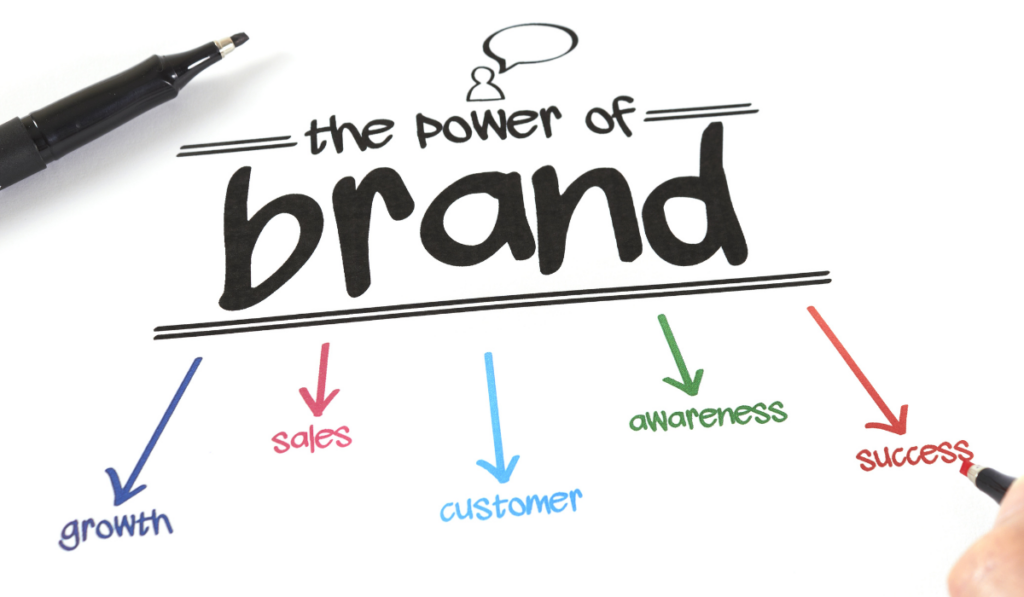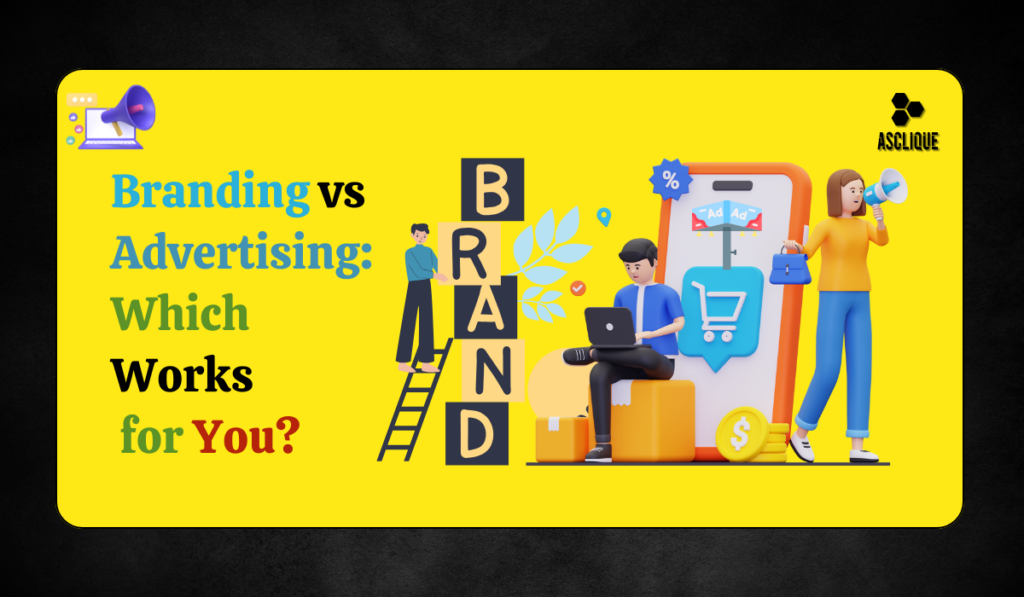The integral foundation of any business marketing strategy is branding and advertising. Although sometimes used interchangeably, they serve their purposes for the long-term success of a corporation. Branding sets the identity for a business, whereas advertising creates awareness and prompts action with strategically crafted messages.
This article discusses the main differentiations between branding and advertising, on the important contributions both make to the business world, and how both can be effectively utilized for business growth.
What is Branding?

The branding process consists of developing a unique niche for any firm by creating a range of attributes that are attractive features to the target market in comparison to those offered by other competitors. Having a business name, logo and color palette designs, message preferences, articulation of values, and experience given to customers- all go in this direction.
Importance of Branding
Professional branding builds trust while credibility draws an emotional tie to customers around their brands. It creates a community of loyal consumers around a brand, builds mass recognition among consumers, and further improves the perceptive value.
Benefits of Branding
- Brand Name: The first impression customers have of your new business. Logo Design – conveys emblematic representation of having a brand identity.
- Brand Voice: Tone and language that is used in communication. Mission and Values – What your business stands for and how it resonates with the consumer at a deeper level.
- Customer Experience: How customers consider and perceive their interactions with the business.
What Is Advertising?

Advertising contains any form of paid messages, providing a means to promote products, services, or brands of a particular business. The central aim is to inform, attract, and eventually sell.
The Importance of Advertising
In general, advertising focuses on the short-term operations of making sales via consumer purchases, while branding concentrates on the long-term growth of an identity and trust. Straightforward advertising is thought to work when it arouses immediate demand so that the consumer can act on it.
Key Types of Advertising
- Digital Advertising: Encompasses social media advertising, pay-per-click (PPC) advertising, and display ads.
- Traditional Advertising: Encompasses TV, radio, and print advertising.
- Influencer Advertising: Partnering with social media influencers for product promotions.
- Content Marketing: The creation of engaging content such as blog posts, videos, and infographics that inform or entertain the target audience.
Branding and Advertising Under Marketing
Not just advertising and branding but more so in consideration of marketing as a total strategy. Together, what they really do is expose, help credibility, and generate income.
Marketing
The entire strategy surrounding the promotion and sale of products or services, including branding (the definition of identity for a business) and advertising (the activities that promote awareness of a business identity and its sales).
Digital Marketing
Very much inclusive, of branding and advertisement. Here businesses are able to pave their way towards customers via online avenues such as social media, search engines, emails, etc., and their respective websites.
Brand Management
Reactively is the managing of the brand with the conviction of keeping it true for its value, giving the name of the game-the way the brand should be presented to customers in different media channels. That could involve logo design, customer care, and anywhere that the brand was going to give some form of coherence or not conflict with advertising campaigns.
Branding vs. Advertising: Key Differences
Though branding and advertising are both integral to marketing success, they have key differences in their objectives and strategies.
| Branding | Advertising |
|---|---|
| Focuses on long-term relationships | Focuses on short-term goals |
| Builds customer loyalty and trust | Drives immediate action and conversions |
| Aims to define the business’s identity | Aims to promote products and services |
| Involves visual, emotional, and value-based communication | Relies on persuasive messaging and calls to action |
How Branding and Advertising Work Together
Molding brand identity and advertising into a harmonious enterprise is paramount in achieving a good marketing strategy. Here is how branding and advertising work in team:
- Brand Identity Drives Effective Advertising: Brand identity ought to feature in every advertising campaign. This reassures consistency and builds the strength of recognition given to the brand.
- Advertising Reinforces Your Brand Message: Advertising is the perfect tool through which to convey the brand’s message to a large audience. Be it TV commercials or digital ads, advertising channels help amplify the voice of the brand.
- Branding Boosts Advertising Impact: A strong brand’s advertising attempts are more likely to be succeeded. When consumers recognize and trust your brand, they are more naturally inclined to believe your ads.
Best Branding Strategies for Success
To create a strong brand that resonates with your target audience, here are some proven branding strategies:
You must know your audience
Knowing the needs, preferences, and pain points of your customers is the very foundation of branding. This knowledge will help you craft messaging and offers directly aimed at them.
Consistency is the name of the game
For brand recognition to flourish, you need to create consistent messaging, graphics, and customer experiences across the board. Be sure to use the same colors and fonts everywhere, and adopt a single tone of voice for the website and social media as well as ads.
Create emotional connections
People don’t buy products; they buy experiences. The focus should be on creating emotional connections with the audience through storytelling, shared values, and meaningful interactions.
Offer superlative customer service
Customer satisfaction is the backbone of a brand. Ensure that your customer service reflects your brand values by being responsive, helpful, and friendly.
Top Advertising Strategies for Maximum Reach
Once your brand is well-established, the next step is leveraging advertising to get your message out there. Below are effective advertising strategies to consider:
Use Social Media Platforms
Social media advertising allows businesses to target a very specific audience; therefore, it is one of the most inexpensive methods of communicating with the target. Advertisement platforms look like Facebook, Instagram, and LinkedIn permit businesses to advertise stamping pinpoint targeting settings.
Engage in Search Engine Marketing (SEM)
Advertisements on search engines like Google Ads, which would purposefully focus on customers who are actively searching for a product or services associated with your business, are a highly effective way of driving immediate traffic and conversion.
Collaborate With Influencers
Influencers are continuing to help brands. When you partner with influencers, you leverage their established audience while also earning their credibility for your brand.
Create Engaging Video Ads
Video ads are some of the most engaging forms of content. Well-placed ads on YouTube or different social media platforms, video content can grab attention effectively and thus convert to higher rates of conversion.
Conclusion
In a competitive world, it has become common knowledge that advertising and branding go hand in hand in the formation of an effective business strategy. Branding creates customer loyalty and emotional attachment over the long haul, while advertising calls attention to a product and brings basic sales and even wider market attention. If both are effectively intertwined, marketing can become far more efficient for corporate growth and sustenance.
And so, we see how branding and advertising play both key roles in the digital marketing and brand management fields so that businesses are not only able to stand out amidst the sea of competitors but will also remain fresh in their consumers’ minds.
FAQs
What’s the difference between branding and advertising?
In branding, one is said to create a long-term identity for a business, whereas advertising targets immediate attention and action with a focused message.
How does branding influence customer loyalty?
By establishing trust and emotional ties with customers, branding enhances customer retention and loyalty over time.
Why is consistency important in branding?
Consistency makes for easy identification of a brand, while also securing the reinforcements of the message from every possible channel, which enhances the identity of the brand.
How do advertising campaigns help in business growth?
Advertising campaigns help reach a large number of consumers into the market, create awareness for the product, and offer to sell it. This in turn equals growth for the business and further market development.
Can branding and advertising work together?
Yes. If branding and advertising work in conjunction with each other, that will produce a consistent message that aids in brand recognition and contributes to both short and long-term business success.

